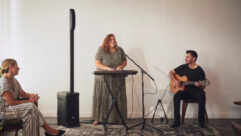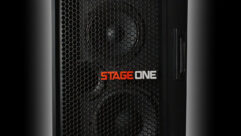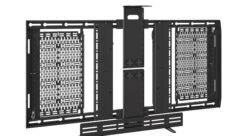

Having recently evaluated Mackie’s unique FreePlay Personal PA, the subsequent arrival of a Reach portable PA (PPA) system for review made a lot of chronological sense. While the “new century boom box” design of the 11lb., battery-powerable FreePlay makes it the easiest PPA I’ve ever traveled with, the significantly larger Reach is entirely practical for use in sound reinforcement applications where a very small footprint yet comprehensive stage and audience coverage is desired—yet all from one box. You heard that right: one Reach enclosure will deliver both main and dual stage monitor duties quite well in many small-to medium-size rooms.
Reach’s size and form are probably its most important attributes: 28.7” high by 9.5” wide by 8.6” deep; it’s a skinny, tall, 31.7lb. self-powered cabinet. It features a built-in 6-channel digital mixer feeding 720W of peak Class D power, which pushes an impressive 150 degrees of horizontal coverage out front (thanks to Mackie’s proprietary ARC array technology) at up to 121dB maximum SPL. Meanwhile, its adjustable EarShot personal monitoring system—consisting of dual side-to-rear firing two-way monitors with an additional 50 degrees of horizontal monitor mix coverage per side—allows performing musicians a built-in monitor on either side of the unit when positioned slightly in front of them.
On Reach’s rear panel are four XLR/TRS combo inputs/preamps plus an 1/8in. aux input and TRS jacks for phones output, footswitch control (to mute/unmute internal effects), link in, and link out connectivity. Its interface is intuitive, too. Simple press/hold button controls allow level and effects send adjustments, side monitor, and oh-so-valuable Feedback Destroyer features. Its four effects—Verb1, Verb2, Delay1, and Delay2—are well chosen, middle of the road acoustic treatments that should suit most common live applications. Preselected EQ voicings are available, as are EarShot speaker selection settings; for the latter, left, right, both, or neither mute options further expand Reach’s on-stage usefulness.
Bluetooth features take Reach to an entirely different level than its closest competition. With the free Mackie Connect mixing app—allowing level, EQ, effects, monitoring, and other adjustments—Reach is truly a tether-free system with the simplest, most logical of touchscreen mixers I’ve had the benefit of using live. Usefully, it pairs with OSX and iOS as well as Android devices. More information about Reach’s Bluetooth-enabled functionality is available on the Mackie website.
I utilized Reach in a wide range of environments with a variety of input sources: most notably for a house of worship (HOW) youth band performance; as a portable DJ rig in a very large school gymnasium at an elementary public school fundraiser; as a main monitor at two different small club gigs with a four-piece cover band; and in a variety of ensemble rehearsal situations. In each case, the Reach performed surprisingly well.
Depending only on its 4-channel internal digital mixer, Reach impressively covers many portable PA applications, though I paired the unit with an external mixer for more channels (most notably in the cover band and HOW scenarios) with much success. The system shined in DJ applications; low-channel count, club-based ensemble sound reinforcement; and is ideal for nearly any typical rehearsal room scenario where vocals, acoustic instruments, and other low SPL sources must mix with other amplified or naturally loud sounds (e.g., drums).
In the gymnasium setting, raft with potential feedback, Reach’s Feedback Destroyer literally saved the evening. As two school representatives roamed with wireless microphones through the crowd, speaking over prerecorded music, sound effects, and such, I punched the appropriate button at least a half-dozen times; Reach scanned for the guilty frequencies, grabbing them and ducking them out in literally a second. In more acoustically friendly environments, one Feedback Destroyer scan is all it took, and those gigs went off without a problem—or a squeal, to be specific.
Reach’s EarShot monitoring system is ingenious and quite amazing, actually. In the club gig setting, we placed Reach at the front of the stage, pole-mounted at about head-height to band members. Standing on either side and slightly behind Reach, monitoring the mix on-stage was a pleasure, as the bassist manned the mix via his iPhone. Only the drummer complained a bit for not hearing the mix very well. I’d simply suggest adding a small powered monitor for any backline players positioned too far away from the Reach cabinet. As such, Reach plus a powered wedge equals nearly 360 of combination main/monitor coverage, all without feedback problems. I tried it later, and all I can say is, “Wow!”
I’ve used Fishman SoloAmp and Bose L1 systems extensively: the closest comparative products I can think of to Mackie’s Reach. At $999 street, Reach is the same street price as the SoloAmp SA220, yet far more powerful, useful, and feature-packed. In direct comparison, Reach is incredibly “bass deep.” An entry-level L1 is available at $899 street and is very nice, indeed, yet it lacks the many features and attractive accessories of a thousands-more fully featured L1, which is closer to what Reach ultimately offers its users.
Further, both these Fishman and Bose rig examples lack Reach’s input count, effects, and Bluetooth-enabled mixing features, and the incredibly useful EarShot monitoring system. For that reason, I highly recommend Reach for any DIY, jack-of-all-trades live audio pro, performer, or band in similar gig situations as illustrated above. Also, it’s an ideal PPA for institutions—schools, HOWs, and other event centers—as it can cover so many applications, is small and lightweight, and is very intuitive.
Strother Bullins is Technology Editor for NewBay Media’s AV/Pro Audio Group, active musician, recordist, and small-venue sound reinforcement wrangler. [email protected]
PRODUCT SUMMARY
COMPANY: Mackie | www.mackie.com
PROS: Incredibly portable; powerful for its size and weight; all-in-one main/monitor speaker system with built-in mixing features; unique to the marketplace; simple to operate.
CONS: Not appropriate for all PPA applications—e.g., it does not allow for stereo coverage.
PRICE (STREET): $999
SPECIFICATIONS
FREQUENCY RESPONSE (-10DB): 62Hz–20kHz
MAXIMUM SPL: 121dB peak
DISPERSION: 150 degrees
POWER RATING: 720W peak power, Class D amplification
LF TRANSDUCER: 6.5in. pulp composite woofer (2x)
HF TRANSDUCER (MAIN): 1in. polyethylene-composite tweeter (3x)
FULL-RANGE SIDEFILL TRANSDUCERS: 4in. pulp composite woofer, 1in. pulp composite tweeter
CROSSOVER FREQUENCY: 2.6kHz
CONNECTORS: 1/8in. TRS input, 4 XLR/TRS combo inputs, ¼in. TRS phones output, ¼in. TRS link in, ¼in. TRS link out, ¼in. TS footswitch
DIMENSIONS: 28.7”x9.5”x8.6” (HxWxD)
NET WEIGHT: 31.7lbs.










